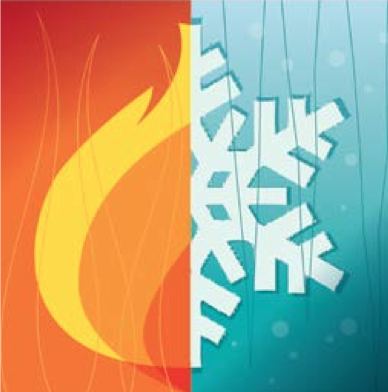 Do you know when to use heat or cold therapy for an injury? If not, a recent review article by two University of Washington sports doctors, Matthew Karl, MD, and Stanley Herring, MD, can be your guide.
Do you know when to use heat or cold therapy for an injury? If not, a recent review article by two University of Washington sports doctors, Matthew Karl, MD, and Stanley Herring, MD, can be your guide.
Drs. Karl and Herring point out that the application of superficial heat to your body can improve the flexibility of your tendons and ligaments, reduce muscle spasms, alleviate pain, elevate blood flow and boost metabolism. The mechanism by which heat relieves pain is not exactly known, although researchers believe that heat inactivates nerve fibers, which can force muscles into irritating spasms, and that heat may induce the release of endorphins, powerful opiate-like chemicals that block pain transmission.
Increased blood flow occurs in heated parts of the body because heat tends to relax the walls of blood vessels. That’s one reason why sports doctors recommend you steer clear of the practice of heating up already inflamed joints. Heat appears to be best for untightening muscles and increasing overall flexibility; the proper tissue temperature for vigorous heating is probably 104 to 113 degrees Fahrenheit (40 to 45 degrees Celsius) and the correct duration of temperature elevation is about five to 30 minutes. Although heating can reduce muscle spasms after a back injury, heat should not be used on sprained ankles.
What about cold treatment?
Cold therapy can also reduce muscle spasms, and cold is noted for killing pain, reducing swelling and lower- ing metabolic activity. Cold’s pain-killing effect is caused by its “deaden- ing” of nerve-cell activ- ity; hospital studies show that patients who use cold therapy on injuries tend to require much less pain medication. This effect, though, can sometimes be counterproductive; an athlete who has “iced down” an injured body part may get so much pain relief that he returns to activity too soon.
Combined with compression, cold can pro- duce dramatic drops in tissue swelling, because cold initially constricts the walls of blood ves- sels and compression restricts the amount of blood that can reach an injured body part (another therapeutic intervention, elevation, helps to “drain” a damaged body region of excess fluid). Studies show that cold produces large decreases in edema (swelling) and better reduction in discomfort, compared to heating.
Cold decreases muscle spasms by making muscles less sensitive to being stretched and, like heat, cold can be used to treat low-back pain. Research suggests that cold works bet- ter for individuals who have had back pain for more than 14 days, while heat may be more effective for those with more recent pain.
Great Debate
The proper duration of cold therapy is currently being hotly debated. Traditionally, doctors have recommended applying cold packs or ice bags to injured areas for 15-30 minutes at a time, but recent research carried out at the University of Brussels indicates that the permeability of lymphatic vessels decreases after about 10 minutes of cold therapy. Since lymphatic vessels drain fluid away from injured tissues and thereby relieve swelling, the Brussels researchers recommend that cold be applied to damaged tissues in no longer than 10-minute intervals (however, individuals with large quantities of subcutaneous fat may require longer periods of icing).
Which form of cold therapy is actually most effective? Again, there’s considerable debate, but recent research suggests that ice chips in a plastic bag are most effective, followed by the use of frozen gel packs and blue ice packs, which in turn are superior to chemical reaction packs and inflatable plastic envelopes injected with a gas refrigerant.
The information for this post was sourced from Karl, M., & Herring, S. (1994). Superficial Heat and Cold: How to Maximise the Benefits. The Physician and Sportsmedicine, 22(12), 65-74.
